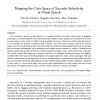Free Online Productivity Tools
i2Speak
i2Symbol
i2OCR
iTex2Img
iWeb2Print
iWeb2Shot
i2Type
iPdf2Split
iPdf2Merge
i2Bopomofo
i2Arabic
i2Style
i2Image
i2PDF
iLatex2Rtf
Sci2ools
COGSCI
2007
2007
Mapping the Color Space of Saccadic Selectivity in Visual Search
Color coding is used to guide attention in computer displays for such critical tasks as baggage screening or air traffic control. It has been shown that a display object attracts more attention if its color is more similar to the color for which one is searching. However, what does similar precisely mean? Can we predict the amount of attention that a display color will receive during a search for a given target color? To tackle this question, two color-search experiments measuring the selectivity of saccadic eye movements and mapping out its underlying color space were conducted. A variety of mathematical models, predicting saccadic selectivity for given target and display colors, were devised and evaluated. The results suggest that applying a Gaussian function to a weighted Euclidean distance in a slightly modified HSI color space is the best predictor of saccadic selectivity in the chosen paradigm. Hue and intensity information by itself provides a basis for useful predictors, spa...
| Added | 12 Dec 2010 |
| Updated | 12 Dec 2010 |
| Type | Journal |
| Year | 2007 |
| Where | COGSCI |
| Authors | Yun Xu, Emily C. Higgins, Mei Xiao, Marc Pomplun |
Comments (0)

